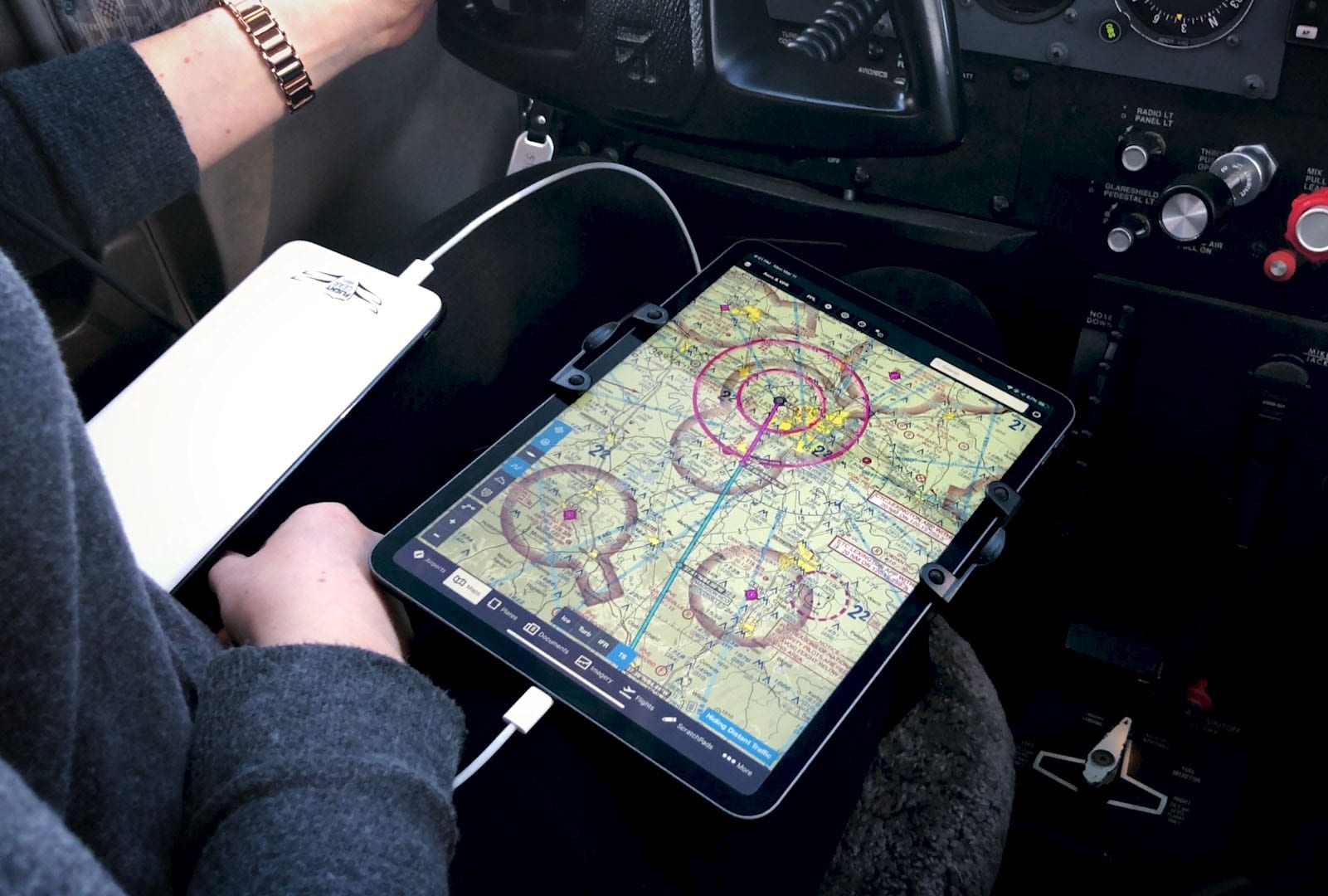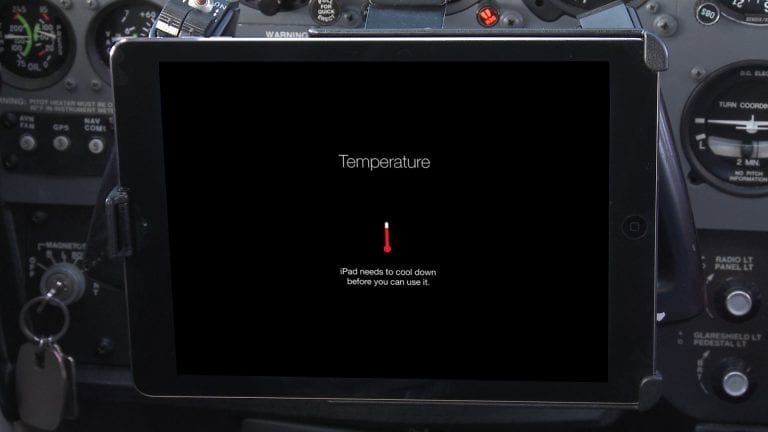
Based on iPad Pilot News reader surveys over the years, the majority of pilots have had the iPad shut down on them at least once in flight due to overheating. This is by far the most common problem reported by pilots when flying with an iPad, but it can be prevented with a little bit of planning and preparation.
Apple lists the normal temperature operating range for the iPad as 32° – 95° F. The recommended temperature for storing your iPad is -4° – 113° F. While there are reports of the iPad shutting down when operating in environments well below freezing, the most likely result will be lagging as you interact with the touchscreen (tip – when operating in cold environments, plug it into a charger and use a case to help generate and retain heat).
The more likely scenario when operating at the extreme ends of the temperature operating range is overheating, which will lead to the iPad entering a thermal protection mode where it will become completely unusable until the internal temperature of the device is reduced. The primary reason for this is to protect the enclosed lithium-polymer battery (bad things can happen if they get too hot).
There are a couple of ways on a typical flight that this can happen and both will catch you off guard if you’re not paying attention. The first scenario can happen when you’re flying in a low-wing airplane en route at altitude with the iPad secured in a kneeboard on your lap. You’re in VFR conditions in sunny weather, but the iPad is out of direct sunlight. Then you make a turn over a waypoint, and the sun begins to shine directly on your iPad’s dark screen without you noticing. Even though the ambient temperature may be well below the 95° F limit, the iPad’s internal temperature will quickly elevate and soon display the overheat warning.

Charging your iPad can exacerbate overheating.
There are several factors that may increase the potential for an overheat situation like this in flight. First, if you’re using the iPad with a fully-enclosed case or kneeboard, you will be restricting airflow around the rear of the iPad, limiting its ability to dissipate heat. Also, charging the iPad from a USB port in the airplane or a backup battery will also increase the internal temperature of the device, increasing the risk for an overheat situation in a hot airplane or near direct sunlight.
The other likely scenario in which your iPad can unexpectedly overheat is after shutting the engine down on the ramp on a hot summer day. Prior to the iPad, many pilots would set their paper charts or kneeboard on the glareshield to get them out of the way. New iPad users might inadvertently do the same thing out of habit. As we all know, the temperature inside the cabin will quickly rise after you shut the door, again putting the iPad in a vulnerable state for potential overheating. Make it a habit to take your iPad with you after shutdown, or store it in a protected part of the airplane to ensure a timely departure when you return.
Your iPad becomes completely unusable when it overheats and will display a temperature warning on the screen. At this point, your only option is to get it to a cooler environment and lower the internal temperature. Remove it from direct sunlight and aim a few air vents over if possible. If you had it in a kneeboard or case, remove these to aid the cooling process, and remove it from any charging sources. Once the iPad’s temperature lowers, it will automatically switch back on—there’s nothing else for you to do at that point, except to keep it out of the sun.
If you fly an airplane that has large windows and lets in a good deal of sunlight to the cabin, your best bet is to consider a yoke or suction cup RAM or Robust mount. These provide plenty of flexibility to pivot the iPad screen away from direct sunlight, and expose more of the front and rear surfaces of the iPad to ambient air for continuous cooling.
If a kneeboard is your only option and overheating is a concern, try raising the iPad slightly above the bottom of the kneeboard to create an open layer of air between it and the backside of the iPad. Many pilots report that adding a few pencils to accomplish this works well. It might be the most polished solution, but it works! For a simpler kneeboard solution that does not restrict airflow, check out the MyClip kneeboard, which does not rely on a traditional rigid base to keep the iPad secure on your lap and allows for more airflow around the device.
You may also want to consider using small sunshades on your windows in flight to help reduce the intensity of the sunlight reaching your iPad. Good options here are the collapsible aircraft sunshades, which attached with suction cups, or slap on sun-visors that cling to the windows on their own.
 Another consideration is to use the X-Naut Cooling Case along with your iPad. This mounting system features built-in fans to circulate cool air, specifically targeted at the iPad’s main hot spots to prevent it from overheating. The mount can be powered off of typical alkaline batteries or USB with a power bank or backup battery.
Another consideration is to use the X-Naut Cooling Case along with your iPad. This mounting system features built-in fans to circulate cool air, specifically targeted at the iPad’s main hot spots to prevent it from overheating. The mount can be powered off of typical alkaline batteries or USB with a power bank or backup battery.
In addition to working with the RAM mount system, you can also turn it into a kneeboard with this accessory kit—perfect for cockpits with a bubble canopy where the iPad is exposed to direct sunlight. The X-Naut is available for the iPad Mini 1-5, the iPad Air 1-2 and 9.7″, the iPad Pro 11″ and Air 4 and the iPad Pro 10.5”/10.2″/iPad Air 2019/iPad (7th Gen).
With a little preparation and some new habits, it’s easy to fly all summer long with an iPad. In fact, after a few early mistakes, we have not suffered an overheating problem in over five years of flying.
The post Prevent iPad overheating issues in the airplane this summer appeared first on iPad Pilot News.
Source: Ipad appsPrevent iPad overheating issues in the airplane this summer
